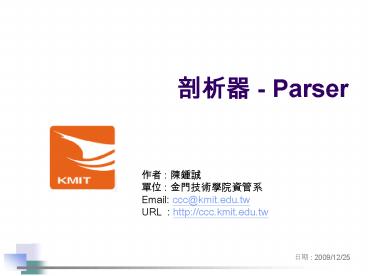Parser - PowerPoint PPT Presentation
1 / 17
Title:
Parser
Description:
... the program is to parse a construct of the form A (rather than to ... Just as in the syntax the construct A is recursive, so is the procedure A recursive: ... – PowerPoint PPT presentation
Number of Views:44
Avg rating:3.0/5.0
Title: Parser
1
??? - Parser
2
Limitation of Regular Expression
- Regular languages are subject to the restriction
that no nested structures can be expressed.
Nested structures can be expressed with the aid
of recursion only (see Chapter 2). - A finite state machine therefore cannot suffice
for the recognition of sentences of context free
languages. - We will nevertheless try to derive a parser
program for the third example in Chapter 2, by
using the methods explained in Chapter 3.
Wherever the method will fail - and it must fail
- lies the clue for a possible generalization. It
is indeed surprising how small the necessary
additional programming effort turns out to be.
3
Can Lexical Analyze Program Recognize Context
Free Grammar
4
Why Fail ?
- NO
- You cannot treat non-terminal as terminal
symbols. - Why ?
- Here we have blindly treated the nonterminal
symbol A in the same fashion as terminal symbols.
This is of course not acceptable. The purpose of
the third line of the program is to parse a
construct of the form A (rather than to read a
symbol A). However, this is precisely the purpose
of our program too.
5
Recursive Descent Parser
- Therefore, the simple solution to our problem is
to give the program a name, that is, to give it
the form of a procedure, and to substitute the
third line of program by a call to this
procedure. Just as in the syntax the construct A
is recursive, so is the procedure A recursive
6
Recursion for Parsing
- The necessary extension of the set of translation
rules is extremely simple. The only additional
rule is - A parsing algorithm is derived for each
nonterminal symbol, and it is formulated as a
procedure - carrying the name of the symbol. The occurrence
of the symbol in the syntax is translated into a
call of the corresponding procedure. - Note this rule holds regardless of whether the
procedure is recursive or not.
7
Deterministic Parser
- It is important to verify that the conditions for
a deterministic algorithm are satisfied. This
implies among other things that in an expression
of the form
8
Left Recursion
- the terms must not feature any common start
symbols. This requirement excludes left
recursion. If we consider the left recursive
production - we recognize that the requirement is violated,
simply because b is a start symbol of A (b IN
first(A)), and because therefore first(A"a") and
first("b") are not disjoint. "b" is the common
element.
9
Eliminate Left Recursion.
- The simple consequence is left recursion can and
must be replaced by repetition. In the example
above - A A "a" "b"
- is replaced by
- A "b" "a".
10
Context Free Grammar v.s. Push Down Automata
- Another way to look at our step from the state
machine to its generalization is to regard the
latter as a set of state machines which call upon
each other and upon themselves. In principle, the
only new condition is that the state of the
calling machine is resumed after termination of
the called state machine. The state must
therefore be preserved. Since state machines are
nested, a stack is the appropriate form of store.
Our extension of the state machine is therefore
called a pushdown automaton. Theoretically
relevant is the fact that the stack (pushdown
store) must be arbitrarily deep. This is the
essential difference between the finite state
machine and the infinite pushdown automaton.
11
Top-Down Parsing ? Recursive Descent Parsing
- The general principle which is suggested here is
the following consider the recognition of the
sentential construct which begins with the start
symbol of the underlying syntax as the uppermost
goal. If during the pursuit of this goal, that
is, while the production is being parsed, a
nonterminal symbol is encountered, then the
recognition of a construct corresponding to this
symbol is considered as a subordinate goal to be
pursued first, while the higher goal is
temporarily suspended. This strategy is therefore
also called goal-oriented parsing. If we look at
the structural tree of the parsed sentence we
recognize that goals (symbols) higher in the tree
are tackled first, lower goals (symbols)
thereafter. The method is therefore called
top-down parsing (Knuth, 1971 Aho and Ullman,
1977). Moreover, the presented implementation of
this strategy based on recursive procedures is
known as recursive descent parsing.
12
EBNF ? RD-Parser
13
Syntax Production
14
production identifier "" expression "." .
15
expression term "" term.
16
term factor factor.
17
Factor
factor identifier string "(" expression ")"
"" expression "" "" expression "".































